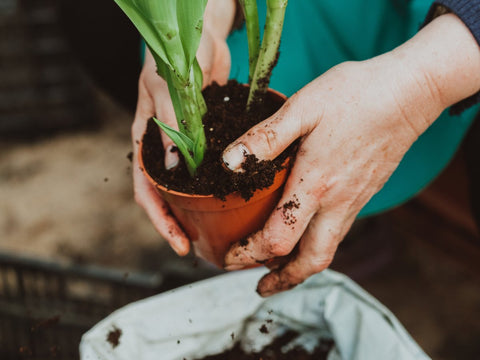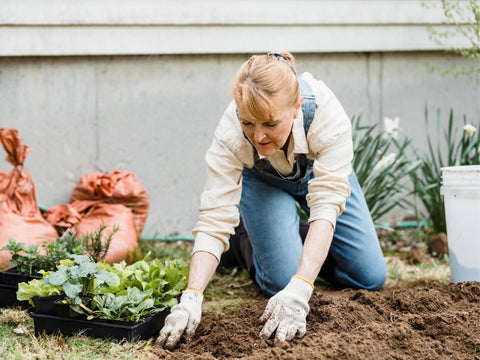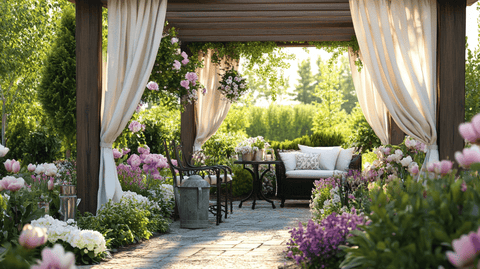The joy of gardening in fall.
The splendor of fall isn't just confined to the glorious reds, oranges, and yellows of the trees. It extends to the garden, where the change in seasons offers a unique window of opportunity for planting. The brisk air combined with the soil's retained warmth from the summer months creates an ideal environment for many plants. Gardening in the fall is a meditative experience, marked by the rustling of fallen leaves and the anticipation of new growth.
Addressing misconceptions about spring planting.
Many assume that spring is the optimal time for introducing new plants to the garden. While spring does provide its advantages, fall planting often goes overlooked, despite its myriad benefits. The perception that fall is a time for ending rather than beginning in the garden realm is a misconception we'll debunk in this guide.
Benefits of Planting in Fall
Advantages of cooler temperatures.
As summer's scorching heat retreats, the cooler days of fall usher in a kinder, gentler climate for plants. These temperatures are less stressful for both plants and gardeners. Reduced evapotranspiration means plants require less water, and the chances of plants getting scorched or stressed from intense sunlight decrease. Moreover, the cooler conditions are more pleasant for gardeners, allowing extended hours of work without the exhaustion that summer gardening often entails.
The warm soil effect.
While the air cools, the ground retains much of the heat from summer, offering a warm embrace for plant roots. This combination of cool air and warm soil is ideal for root development. Roots tend to grow and establish themselves better in these conditions, leading to stronger, more resilient plants that are well-prepared to flourish come spring.
Preparing plants for spring growth.
Planting in the fall sets the stage for a spectacular spring show. As these plants get a head start in the fall, they're poised to shoot up and out once winter recedes. By the time spring planters are just setting their plants into the ground, fall planters are already enjoying lush growth and, in some cases, early blooms. It's an early reward for the foresight and effort invested in autumn.
Trees and Shrubs: The Backbone of Your Garden
The case for autumn tree planting.
Trees and shrubs form the architectural foundation of any garden. Their stature, spread, and perennial presence bring structure and a sense of permanence. When you plant trees and shrubs in the fall, you provide them with an opportunity to establish their roots in the nurturing embrace of warm soil even before the first frost sets in. By the time winter arrives, these plants are better equipped to face the cold, and by spring, they're well on their way to robust growth. Here are some of the best trees and shrubs to consider for fall planting:
Dogwood

The Dogwood, with its beautiful blossoms and vibrant fall foliage, is a stellar addition to any garden. When planted in the fall, it benefits from the cooler weather, which reduces transplant shock, allowing it to settle and grow stronger before winter.
Tulip Tree

Known for its unique tulip-shaped leaves and flowers, the Tulip Tree is not only an ornamental delight but also grows quickly when its roots take in the fall's warmth. Its bright yellow fall foliage is an added bonus, making it a garden favorite.
Oak

Oaks are a symbol of strength and endurance. Planting them in the fall allows these mighty trees to establish themselves firmly, ensuring they stand tall and majestic for years, if not centuries, to come.
Witch Hazel

Witch Hazel is a shrub that offers multi-seasonal interest. Its fragrant yellow flowers bloom in late fall to early winter, defying the usual trends and bringing joy to a garden even as most plants go dormant. Planting in the fall ensures a robust bloom in the coming seasons.
Perennials: Come Back Every Year
Why fall is perfect for perennials.
Perennials are the garden gifts that keep on giving. Unlike annuals, which complete their lifecycle in a single season, perennials return year after year, bringing consistent beauty to your garden. Planting perennials in the fall offers them a chance to establish their roots deeply and comfortably before winter. This head start ensures that when spring arrives, these plants are ready to burst forth in all their glory, while others are just starting out. Here's a look at some must-have perennials for fall planting:
Asters

Asters are quintessential fall perennials, blooming profusely when many other plants are winding down. With their star-shaped flowers in shades of purple, pink, and white, they provide a splash of color in autumn gardens. By planting them in the fall, you ensure a more vigorous bloom the following year.
Sedum

Sedums, often referred to as stonecrops, are succulent perennials that thrive in well-drained soils. Their thick leaves retain moisture, making them somewhat drought-resistant. The fall variety, 'Autumn Joy', lives up to its name by displaying brilliant pink and rust-colored flowers in the later months of the year. Fall planting strengthens its resilience and prepares it for a glorious show.
Goldenrod

Often mistakenly blamed for hay fever (a misidentification, as ragweed is the real culprit), Goldenrod is a vibrant perennial that lights up the fall garden with its bright yellow plumes. Planting Goldenrod in the fall ensures that this perennial is well-rooted and ready to attract butterflies the following year.
Japanese Anemone

Japanese Anemones are elegant fall-blooming perennials that sway gracefully on tall stems. Their delicate pink or white blossoms with golden centers are a joy to behold. By planting them in autumn, you allow them to establish a strong root system, ensuring a more prolific bloom in subsequent seasons.
Fall Vegetables: Harvest Before Winter
The joy of autumn vegetable gardens.
While most think of vegetable gardening as a spring and summer pursuit, fall offers its own set of delectable edibles. The shorter days and cooler temperatures bring a flavor intensity to certain vegetables that can't be matched in the heat of summer. Plus, there's a particular satisfaction in harvesting crisp vegetables from under a blanket of fall leaves or even the first frosts. Let's explore some vegetables that thrive when planted in the fall:
Kale

Kale is a hardy green that not only survives but thrives in cooler temperatures. Its flavor becomes notably sweeter after a frost. Whether you enjoy it in smoothies, salads, or sautés, planting kale in the fall provides fresh, nutritious greens throughout the season.
Brussels Sprouts

These mini cabbage-like vegetables have a bad reputation from childhood dinners, but when freshly harvested from a fall garden, they're an entirely different experience. The chilly weather enhances their natural sweetness, making them a delightful addition to autumn meals.
Radishes

For those looking for a quick-growing crop, radishes are ideal. These crunchy, peppery roots can be ready to harvest in as little as three to four weeks after planting. Their spicy bite becomes milder and more succulent when grown in the coolness of fall.
Spinach

Spinach is another leafy green that prefers the cooler days of fall. It germinates quickly and provides tender leaves that are perfect for salads, sandwiches, and more. Plus, in many regions, if protected, spinach can continue growing well into winter, providing a consistent supply.
Bulbs for Spring Blooms
Forward-thinking: spring blooms in fall.
Planting bulbs in the fall is like sending a letter to your future self. While they lie dormant beneath the soil during the cold winter months, they're secretly preparing to surprise you with vibrant blooms when spring arrives. This long-term investment pays off handsomely, providing your garden with some of the earliest and most eagerly anticipated flowers of the year. Let's delve into some bulbs that you should be planting this fall for a colorful spring:
Tulips

A classic choice, tulips come in a mesmerizing array of colors and forms. From the classic single blooms to fringed, parrot, or double varieties, there's a tulip for every garden aesthetic. Plant them en masse for a spectacular spring display.
Daffodils

These cheerful yellow or white flowers are often among the first signs that winter is retreating. Not only are they beautiful, but daffodils are also deer and rodent-resistant, making them a practical choice for many gardens.
Garlic

While not a flower, garlic is an essential fall-planted bulb for the edible garden. Plant individual cloves pointy end up in the fall, and by summer, you'll be rewarded with full heads of aromatic garlic. Bonus: garlic is known to repel certain pests, offering a protective edge to your garden.
Crocus

Often poking through the snow, crocuses are a delightful herald of spring. Their delicate purple, yellow, or white blooms are a refreshing sight after the monochromatic palette of winter. They're also one of the first forage sources for early-emerging pollinators.
Grasses for Fall Interest
Grasses’ role in the fall garden.
Ornamental grasses are often the unsung heroes of the autumn garden. While they may not offer the vivid blooms of some other plants, their textured foliage, graceful movement, and unique seed heads add a distinct layer of interest. In the fall, many grasses transform into hues of gold, bronze, and red, capturing the essence of the season. Their wispy plumes and stalks also create a mesmerizing play of light and shadow, especially during the golden hours of dawn and dusk. Let's explore some standout grasses that can elevate the aesthetics of your fall garden:
Switchgrass

Switchgrass, or Panicum virgatum, is a native North American prairie grass known for its upright form and adaptability. In the fall, its green blades turn golden yellow, often with hints of red, providing a warm backdrop or contrast in the garden. The feathery seed heads add a soft texture and can also be a food source for birds during the winter months.
Fountain Grass

Pennisetum alopecuroides, commonly known as Fountain Grass, is beloved for its arching clumps of slender leaves and bottlebrush plumes. These plumes, which emerge in late summer, persist into the fall and even winter, swaying gracefully with every breeze. The fall foliage of this grass often takes on coppery or reddish hues, enhancing its visual appeal.
Care Tips for New Plants
Keeping plants hydrated and protected.
Even as temperatures drop, it's crucial to keep newly planted specimens well-watered. Fall can bring unpredictable rainfall, so ensure your plants receive a consistent amount of moisture. This aids in root establishment and prepares them for winter dormancy. Additionally, consider using row covers or frost cloths for tender plants that might be susceptible to early frosts. This provides an extra layer of protection against sudden temperature drops.
Mulching and its benefits.
Mulch is a gardener's best friend, especially in the fall. Applying a thick layer of organic mulch, like straw, leaves, or wood chips, around your plants serves multiple purposes. It insulates the soil, maintaining a more consistent temperature; helps retain soil moisture; and suppresses weed growth. Moreover, as organic mulch breaks down, it enriches the soil with essential nutrients, promoting plant health.
Fertilizing: The dos and don'ts.
While fertilizing can be beneficial, it's essential to approach it with caution in the fall. Avoid high-nitrogen fertilizers, which can stimulate new growth that might not harden off before winter, making plants more vulnerable to frost damage. Instead, opt for balanced or phosphorous-rich fertilizers, which support root growth and overall plant health. Always refer to plant-specific guidelines and conduct a soil test if you're unsure about your garden's nutrient needs.






























Comments (0)
There are no comments for this article. Be the first one to leave a message!